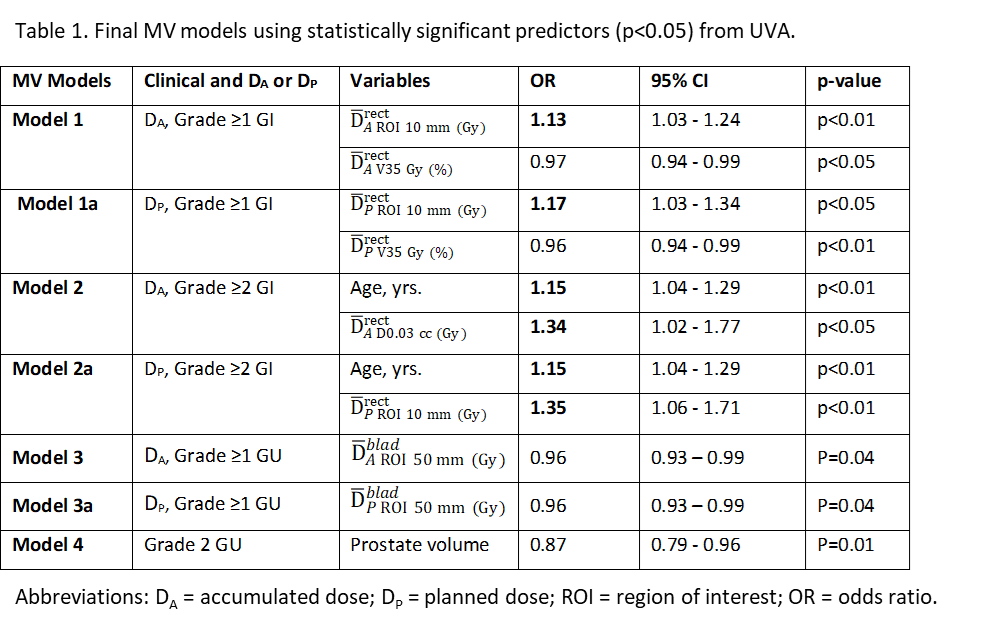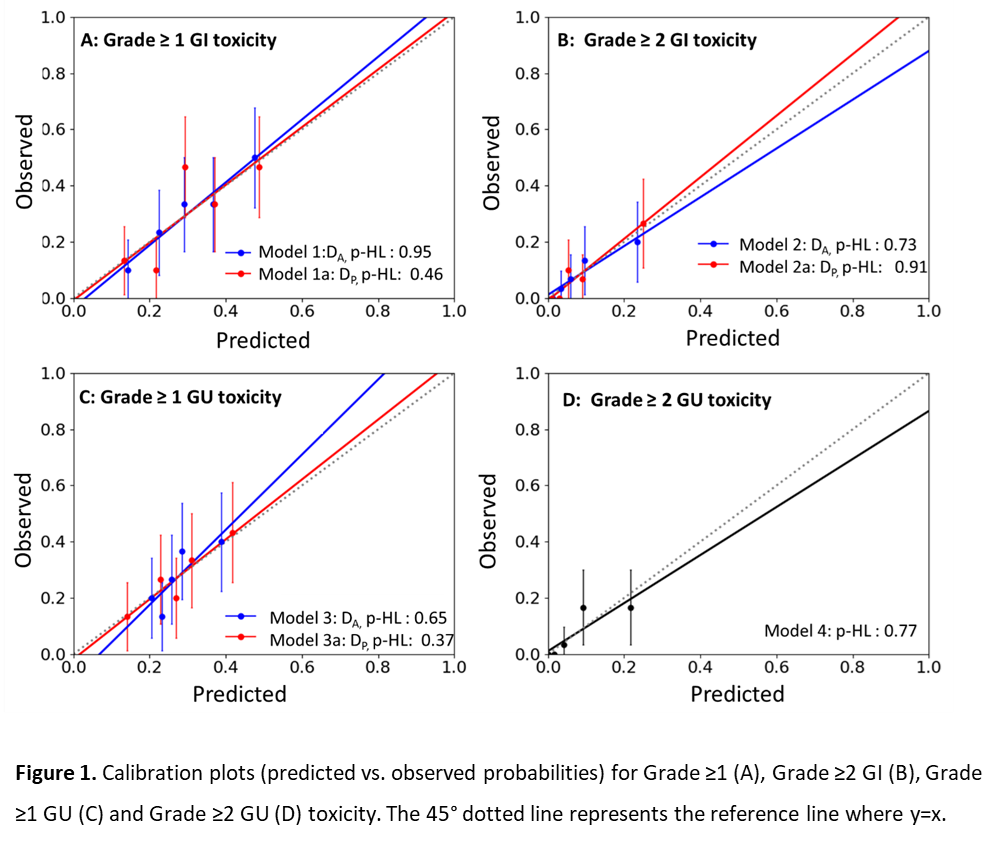Late toxicity predictors in high-risk prostate cancer radiotherapy using accumulated delivered dose
PO-2118
Abstract
Late toxicity predictors in high-risk prostate cancer radiotherapy using accumulated delivered dose
Authors: Ashley Ong1,2, Vanessa Panettieri2,3, Mathew Dimmock2,4, Jeffrey Tuan1, Hong Qi Tan1, Caroline Wright2
1National Cancer Centre Singapore, Division of Radiation Oncology, Singapore, Singapore; 2Monash University, Department of Medical Imaging and Radiation Sciences, Clayton, Australia; 3Alfred Hospital , Alfred Health Radiation Oncology, Melbourne , Australia; 4Keele University , School of Allied Health Professions, Staffordshire, United Kingdom
Show Affiliations
Hide Affiliations
Purpose or Objective
Large variations between planned (DP) and accumulated dose (DA) have been reported in patients treated for prostate radiotherapy (RT). This study aimed to determine the predictors for late Grade ≥1 and 2 gastrointestinal (GI) and genitourinary (GU) toxicity with clinical and DP or DA as dosimetric variables respectively. DA was generated using an automated dose accumulation workflow based on patient’s daily acquired cone-beam computed tomography images.
Material and Methods
Dose-volume (DV) metrics of the organs at risk (OARs) were evaluated between DA and DP for 150 high-risk prostate cancer (HR-PCa) patients. Additionally, mean doses derived from a novel dose-based-region of interest (DB-ROI) structures generated within the dose accumulation workflow were analysed. Multivariate analysis (MVA) was performed using significant clinical and dosimetric variables defined as p<0.05 during univariate analysis (UVA). Model performance was measured with respect to its calibration results and discriminative ability. Subgroup analysis was performed on predictors with odds-ratio (OR) of > 1. All analyses were performed using SPSS statistics (IBM Corp. v27.0. Armonk, NY) and R software (https://www.r-project.org/, version 4.0, Vienna, Austria).
Results
Rectal DA demonstrated a higher intermediate-high dose (V30-65 Gy and DB-ROI at 15-50 mm) compared to DP. Conversely, at the very high dose region, rectal DA (V75 Gy and DB-ROI at 5-10 mm) were significantly lower. Bladder DA intermediate-high dose (V30-65 Gy and DB-ROI-20-50 mm) increased compared to DP. In contrast, at the very high dose region, DA (D0.003 cc, V70-75 Gy, and DB-ROI-5-10 mm) were significantly lower. In MVA, rectal DB-ROI-10 mm was predictive for Grade ≥1 GI toxicity for DP and DA. Age, rectal DA for D0.03 cc, and rectal DP for DB-ROI-10 mm were predictors for Grade 2 GI toxicity (Table 1). Subgroup analysis showed that patients ≥72 years old and a rectal DA of ≥78.2 Gy were highly predictive of Grade 2 GI toxicity. For GU toxicity, single variable models were generated with OR <1. DB-ROI-50 mm was predictive of Grade ≥1 GU toxicity for DA and DP. Prostate volume was significant in predicting Grade 2 GU toxicity (Table 1). All MV models demonstrated good model performance and have achieved an AUC of > 0.6 (Figure 1).


Conclusion
The dosimetric impact of a higher OARs dose in DA due to volumetric changes was minimal and was not predictive of detrimental clinical toxicity apart from rectal D0.03 cc ≥78.2Gy for Grade 2 GI toxicity. For GU toxicity, smaller prostate volumes demonstrated a minor protective effect. The developed MV models for HR-PCa treated using inverse planning techniques to predict the risk of late GI and GU toxicity at two years post-RT follow-up will be able to provide recommendations to facilitate dose escalation strategies.